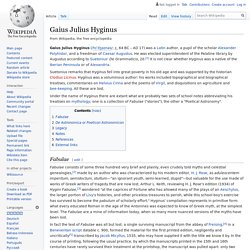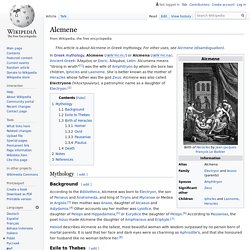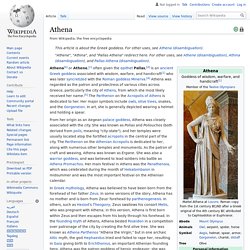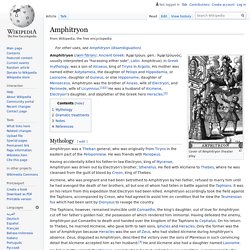

Milky Way Myths from all over the World. THE MILKY WAY TELLING IN ANCIENT TEXTS References to the very fine website of Anne Wright Excerpt: "There is a high track, seen when the sky is clear, called the Milky Way, and known for its brightness.

This way the gods pass to the palaces and halls of the mighty Thunderer [Zeus/Jupiter]. To right and left are the houses of the greater gods, doors open and crowded. The lesser gods live elsewhere. Here the powerful and distinguished have made their home. This is the place, if I were to be bold, I would not be afraid to call high heavens Palatine. " Figure 6. Www.greek-gods. The Creation of the Milky Way - Greek Legends and Myths.
List of Greek mythological figures. Cronus. Ruler of the Titans in Ancient Greek mythology.

Saturn. Sixth planet from the Sun in the Solar System Physical characteristics Composite image comparing the sizes of Saturn and Earth Saturn is a gas giant because it is predominantly composed of hydrogen and helium.

It lacks a definite surface, though it may have a solid core.[23] Saturn's rotation causes it to have the shape of an oblate spheroid; that is, it is flattened at the poles and bulges at its equator. Its equatorial and polar radii differ by almost 10%: 60,268 km versus 54,364 km.[5] Jupiter, Uranus, and Neptune, the other giant planets in the Solar System, are also oblate but to a lesser extent. Saturn is the only planet of the Solar System that is less dense than water—about 30% less.[25] Although Saturn's core is considerably denser than water, the average specific density of the planet is 0.69 g/cm3 due to the atmosphere. Internal structure. Rhea. From Wikipedia, the free encyclopedia Jump to navigationJump to search Rhea may refer to: Mythology[edit] Science and technology[edit] Places[edit] Ops. Ancient Roman goddess of fertility and the earth In ancient Roman religion, Ops or Opis (Latin: "Plenty") was a fertility deity and earth goddess of Sabine origin.

De Astronomica. De Astronomica, also known as Poeticon Astronomicon,[1] is a book of stories whose text is attributed to "Hyginus", though the true authorship is disputed.

Gaius Julius Hyginus. Gaius Julius Hyginus (; c. 64 BC – AD 17) was a Latin author, a pupil of the scholar Alexander Polyhistor, and a freedman of Caesar Augustus.

He was elected superintendent of the Palatine library by Augustus according to Suetonius' De Grammaticis, 20.[1] It is not clear whether Hyginus was a native of the Iberian Peninsula or of Alexandria. Suetonius remarks that Hyginus fell into great poverty in his old age and was supported by the historian Clodius Licinus. Hyginus was a voluminous author: his works included topographical and biographical treatises, commentaries on Helvius Cinna and the poems of Virgil, and disquisitions on agriculture and bee-keeping. All these are lost. Under the name of Hyginus there are extant what are probably two sets of school notes abbreviating his treatises on mythology; one is a collection of Fabulae ("stories"), the other a "Poetical Astronomy".
Alcmene. In Greek mythology, Alcmene () or Alcmena (; Ancient Greek: Ἀλκμήνη or Doric: Ἀλκμάνα, Latin: Alcumena means "strong in wrath"[1]) was the wife of Amphitryon by whom she bore two children, Iphicles and Laonome.

She is better known as the mother of Heracles whose father was the god Zeus. Alcmene was also called Electryone (Ἠλεκτρυώνην), a patronymic name as a daughter of Electryon.[2] Mythology[edit] Background[edit] Hesiod describes Alcmene as the tallest, most beautiful woman with wisdom surpassed by no person born of mortal parents. Exile to Thebes[edit] Athena. Ancient Greek goddess of wisdom and battle strategy Athena[b] or Athene,[c] often given the epithet Pallas,[d] is an ancient Greek goddess associated with wisdom, handicraft, and warfare[3] who was later syncretized with the Roman goddess Minerva.

Athena was regarded as the patron and protectress of various cities across Greece, particularly the city of Athens, from which she most likely received her name. She's usually shown in art wearing a helmet and holding a spear. Her major symbols include owls, olive trees, snakes, and the Gorgoneion. From her origin as an Aegean palace goddess, Athena was closely associated with the city. Heracles. Origin Many popular stories were told of his life, the most famous being The Twelve Labours of Heracles; Alexandrian poets of the Hellenistic age drew his mythology into a high poetic and tragic atmosphere.[4] His figure, which initially drew on Near Eastern motifs such as the lion-fight, was widely known.

Heracles was the greatest of Hellenic chthonic heroes, but unlike other Greek heroes, no tomb was identified as his. Heracles was both hero and god, as Pindar says heros theos; at the same festival sacrifice was made to him, first as a hero, with a chthonic libation, and then as a god, upon an altar: thus he embodies the closest Greek approach to a "demi-god".[4] Hero or god Heracles' role as a culture hero, whose death could be a subject of mythic telling (see below), was accepted into the Olympian Pantheon during Classical times.
Amphitryon. Cover of Amphitryon theater play.

Mythology[edit] Alcmene, who was pregnant and had been betrothed to Amphitryon by her father, refused to marry him until he had avenged the death of her brothers, all but one of whom had fallen in battle against the Taphians. It was on his return from this expedition that Electryon had been killed. Amphitryon accordingly took the field against the Taphians, accompanied by Creon, who had agreed to assist him on condition that he slew the Teumessian fox which had been sent by Dionysus to ravage the country.
Hercules. Heracles. Hera. Alcmene. Zeus. Name The Chariot of Zeus, from an 1879 Stories from the Greek Tragedians by Alfred Church. The god's name in the nominative is Ζεύς Zeús /zdeús/. It is inflected as follows: vocative: Ζεῦ / Zeû; accusative: Δία / Día; genitive: Διός / Diós; dative: Διί / Dií. Heracles. Milky Way. Spiral galaxy containing our Solar System The Milky Way is a barred spiral galaxy with an estimated visible diameter of 150-200,000 light-years,[9][24][25] an increase from traditional estimates of 100,000 light-years.
Recent simulations suggest that a dark matter disk, also containing some visible stars, may extend up to a diameter of almost 2 million light-years.[11][12]